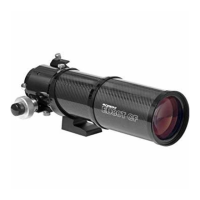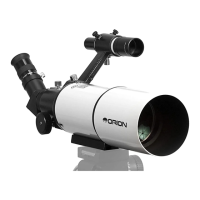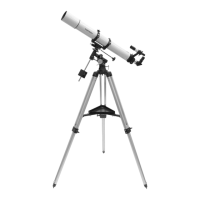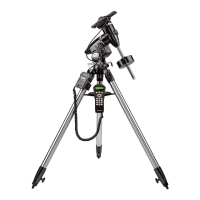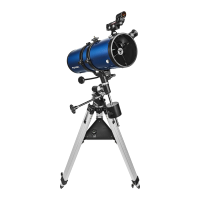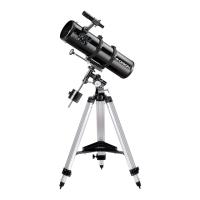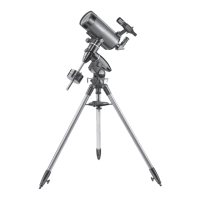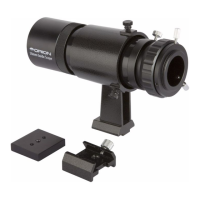12
For example, the CT80 EQ has a focal length of 400mm, which
when used with the supplied 25mm eyepiece yields:
400 mm
= 16x
25 mm
The magnication provided by the 10mm eyepiece is:
400 mm
= 40x
10 mm
The maximum attainable magnication for a telescope is directly
related to how much light it can gather. The larger the aperture,
the more magnication is possible. In general, a gure of 50x per
inch of aperture is the maximum attainable for most telescopes.
Going beyond that will yield simply blurry, unsatisfactory views.
Your CT80 EQ has an aperture of 80mm, or 3.1 inches, so the
maximum magnication would be about 155x (3.1 x 50). This
level of magnication assumes you have ideal atmospheric con-
ditions for observing (which is seldom the case).
Keep in mind that as you increase magnication, the brightness
of the object viewed will decrease; this is an inherent principle
of the laws of physics and cannot be avoided. If magnication is
doubled, an image appears four times dimmer. If magnication is
tripled, image brightness is reduced by a factor of nine!
So start by using the 25mm eyepiece, then try switching to the
10mm eyepiece later if you want to boost the magnication.
Focusing the Telescope
To focus the telescope, turn the focus wheels (Figure 12)
forward or back until you see your target object (e.g., stars,
the Moon, etc.) in the eyepiece. Then make ner adjustments
until the image is sharp. If you’re having trouble achieving ini-
tial focus, rack the focuser drawtube all the way in using the
focus wheels, then while looking into the eyepiece slowly turn
the focus wheels so that the drawtube extends outward. Keep
going until you see your target object come into focus. Note
that when you change eyepieces you may have to adjust the
focus a bit to get a sharp image with the newly inserted eye-
piece.
On the top of the focuser housing is the drawtube tension
knob (Figure 12). Use it to adjust the amount of friction on
the motion of the focuser drawtube when turning the focus
wheels.
What to Expect
So what will you see with your telescope? You should be able to
see bands on Jupiter, the rings of Saturn, craters on the Moon,
the waxing and waning of Venus, and many bright deep-sky
objects such as star clusters and nebulas. Do not expect to see
colors in faint objects as you do in photographs, however. Most
galaxies and nebulas will appear gray in color. Unlike a camera,
which can record colors of faint objects in long exposures, our
eyes are not sensitive enough to see such color except in a few
of the brightest ones.
Objects to Observe
Now that you are all set up and ready to go, one critical decision
must be made: what to look at?
A. The Moon
With its rocky surface, the Moon is one of the easiest and most
interesting objects to view with your telescope. Lunar craters,
maria, and even mountain ranges can all be clearly seen from
a distance of 238,000 miles away! With its ever-changing phas-
es, you’ll get a new view of the Moon every night. The best time
to observe our one and only natural satellite is during a partial
phase, that is, when the Moon is not full. During partial phases,
shadows are cast on the surface, which reveal more detail, espe-
cially right along the border between the dark and light portions
of the disk (called the “terminator”). A full Moon is too bright and
devoid of surface shadows to yield a pleasing view. Make sure
to observe the Moon when it is well above the horizon to get the
sharpest images.
Use an optional Moon lter to dim the Moon when it is very bright.
It simply threads onto the bottom of the eyepieces (you must rst
remove the eyepiece from the focuser to attach a lter). You’ll nd
that the Moon lter improves viewing comfort, and helps to bring
out subtle features on the lunar surface.
B. The Planets
The planets don’t stay put like the stars, so to nd them you
should refer to the monthly star charts at OrionTelescopes.
com, or to charts published monthly in Astronomy, Sky &
Telescope, or other astronomy magazines. Venus, Mars,
Jupiter, and Saturn are the brightest objects in the sky after
the Sun and the Moon. Other planets may be visible but will
likely appear star-like. Because planets are quite small in
apparent size, optional higher-power eyepieces or a Barlow
lens are recommended and often needed for detailed obser-
vations.
B. The Sun
You can change your nighttime telescope into a daytime Sun
viewer by installing an optional full-aperture solar lter over
the front opening of the telescope. The primary attraction is
sunspots, which change shape, appearance, and location
daily. Sunspots are directly related to magnetic activity in the
Sun. Many observers like to make drawings of sunspots to
monitor how the Sun is changing from day to day.
Important Note: Do not look at the Sun with any optical
instrument without a professionally made solar lter, or per-
manent eye damage could result.
D. The Stars
Stars will appear like twinkling points of light. Even powerful
telescopes cannot magnify stars to appear as more than a
point of light. You can, however, enjoy the different colors of
the stars and locate many pretty double and multiple stars.
The famous “Double-Double” in the constellation Lyra and the
gorgeous two-color double star Albireo in Cygnus are favor-
ites. Defocusing a star slightly can help bring out its color.
E. Deep-Sky Objects
Under dark skies, you can observe a wealth of fascinating
deep-sky objects, including gaseous nebulas, open and
globular star clusters, and different types of galaxies. Most
deep-sky objects are very faint, so it is important you nd an
observing site well away from light pollution.

